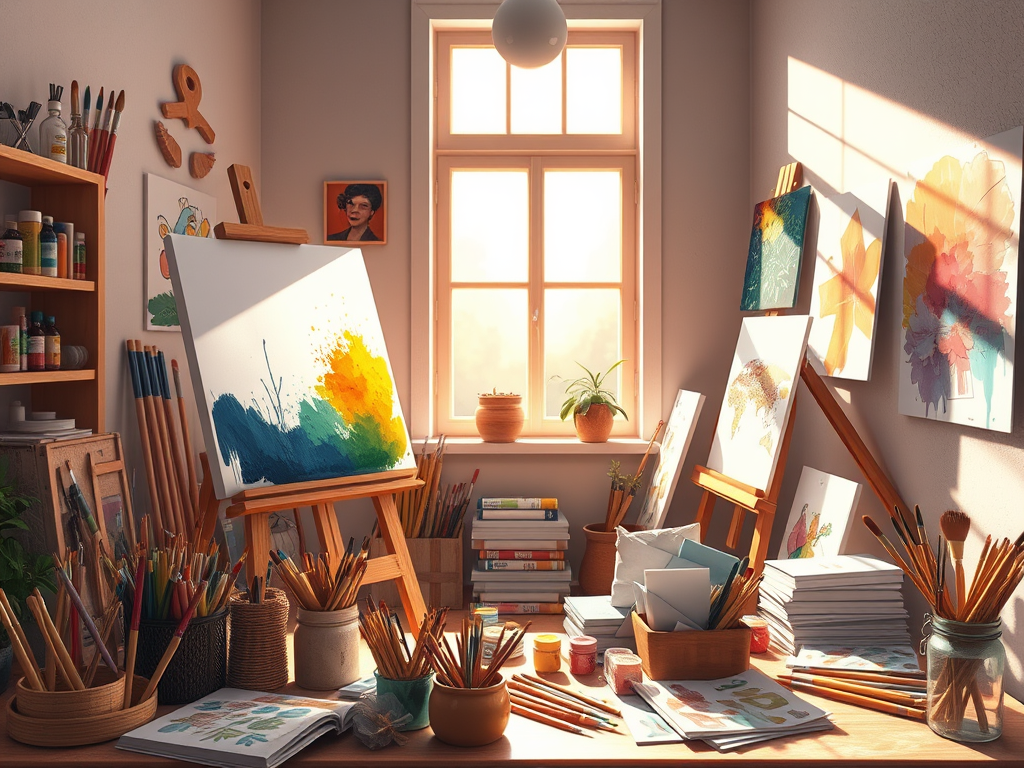The therapeutic power of working with clay and sculpting materials goes far beyond creating beautiful objects. When you press your hands into cool, malleable clay, you’re not just making art – you’re engaging in one of the most grounding and calming activities available for mental health: tactile arts. The tactile and three-dimensional nature of sculpting, particularly with clay, provides a uniquely grounding experience that can be profoundly calming for the nervous system and offers a powerful pathway to emotional wellness.
Key Points Summary:
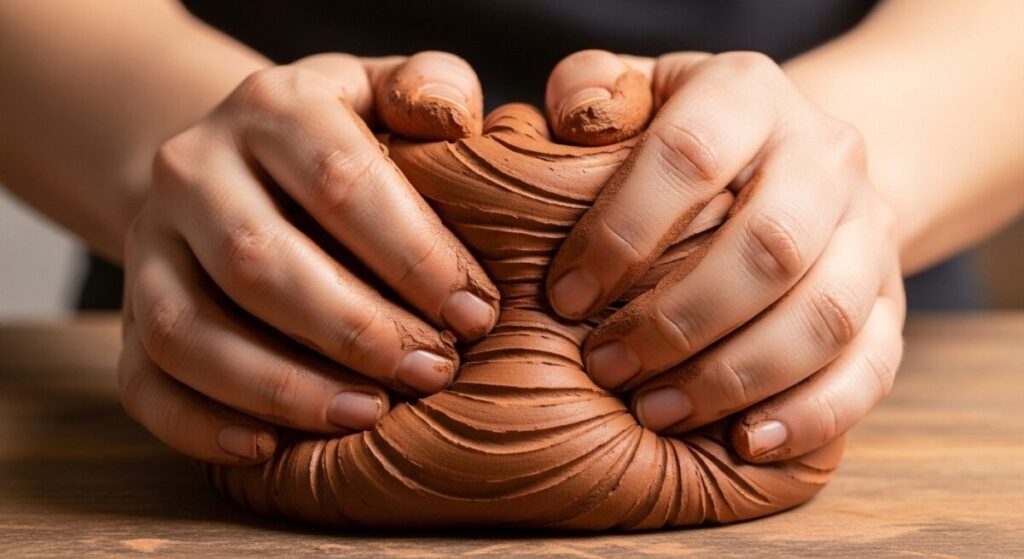
- Clay work naturally calms the nervous system through tactile engagement
- Sculpting pulls attention into the present moment, reducing anxiety
- Physical manipulation of clay serves as both stress relief and creative expression
- Three-dimensional art forms provide unique therapeutic benefits
- Simple clay exercises can help process emotions and create feelings of safety
The physical act of kneading, rolling, shaping, and molding clay demands complete focus and pulls attention away from ruminative or anxious thoughts, anchoring you firmly in the direct, sensory experience of the present moment. This immediate engagement with materials represents a core principle of art therapy activities for stress relief, where the process matters more than the final product.
The Science Behind Clay’s Calming Effects
Research has consistently demonstrated the effectiveness of working with clay in reducing anxiety and promoting emotional regulation. The rhythmic, repetitive motions involved in clay work activate the same neural pathways as meditation, creating what neuroscientists call a “flow state.” This state of focused attention helps quiet the default mode network in the brain – the same network that becomes overactive during depression and anxiety.
When we engage with clay, several therapeutic mechanisms activate simultaneously:
- Bilateral stimulation: Using both hands engages both brain hemispheres
- Sensory grounding: Multiple senses anchor attention in the present
- Motor regulation: Physical movement helps process stored trauma and stress
- Creative expression: Non-verbal communication of internal experiences
According to the American Art Therapy Association, tactile arts like clay work are particularly effective because they bypass the verbal processing centers of the brain, allowing for direct emotional expression and release.
Mindful Kneading and Shaping: Your Gateway to Presence
One of the most accessible and powerful clay therapy techniques requires no artistic skill whatsoever. The practice of mindful kneading transforms a simple piece of clay into a vehicle for present-moment awareness and stress relief.
The Basic Technique
Start with a piece of clay about the size of your fist – any type will work, from air-dry clay to traditional pottery clay. The goal isn’t to create anything specific; instead, focus entirely on the physical sensations:
- The coolness of the clay against your palms
- Its unique texture and weight
- The feeling of resistance as you apply pressure
- The satisfying yield as the material responds to your touch
This exercise serves as a physical outlet for stress and tension, much like a stress ball, but with an added creative dimension that engages multiple parts of your brain simultaneously. Many practitioners report feeling significantly calmer after just 10-15 minutes of mindful clay work.
Sculpting an Emotion: Making the Invisible Visible
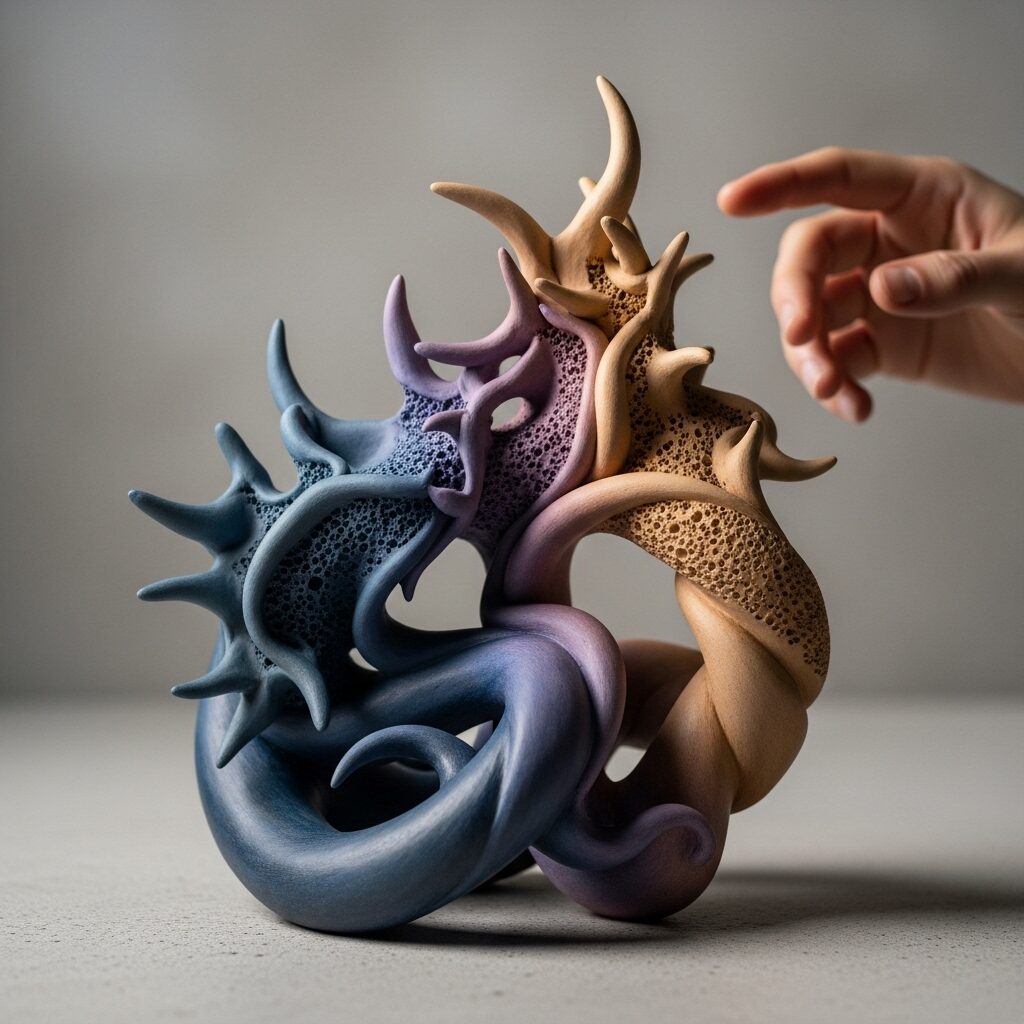
One of the most powerful aspects of clay work is its ability to give physical form to abstract experiences. The technique of “sculpting an emotion” involves translating internal feelings into three-dimensional objects, making the invisible visible and the intangible tangible.
How to Practice Emotional Sculpting
Begin by identifying a feeling you’re currently experiencing – it could be anxiety, joy, frustration, or hope. Then ask yourself:
- What shape would this emotion take?
- What texture would it have – smooth, rough, spiky, or flowing?
- Would it be heavy or light?
- Large or small?
- Dense or hollow?
Allow your hands to work intuitively with the clay, letting the emotion guide the form rather than your conscious mind. This process of externalization can make overwhelming emotions feel more manageable and understandable, providing a non-verbal means of processing complex feelings.
Dr. Cathy Malchiodi, a leading art therapy researcher, notes that
“When we give form to our emotions through clay, we create a relationship with them rather than being consumed by them.”
This relationship allows for observation, understanding, and ultimately, transformation.
Case Study: Anxiety Takes Shape
Sarah, a college student dealing with exam stress, described her anxiety as “a tight knot in my chest that keeps growing.” Working with clay, she created a twisted, knotted form that perfectly captured her internal experience. Over several sessions, she gradually worked with the clay, slowly unraveling the knots and reshaping the form into something more flowing and peaceful. The physical act of transformation in the clay helped her develop tools for managing her anxiety in real life.
Creating a “Safe Space” Sculpture: Your Tangible Anchor
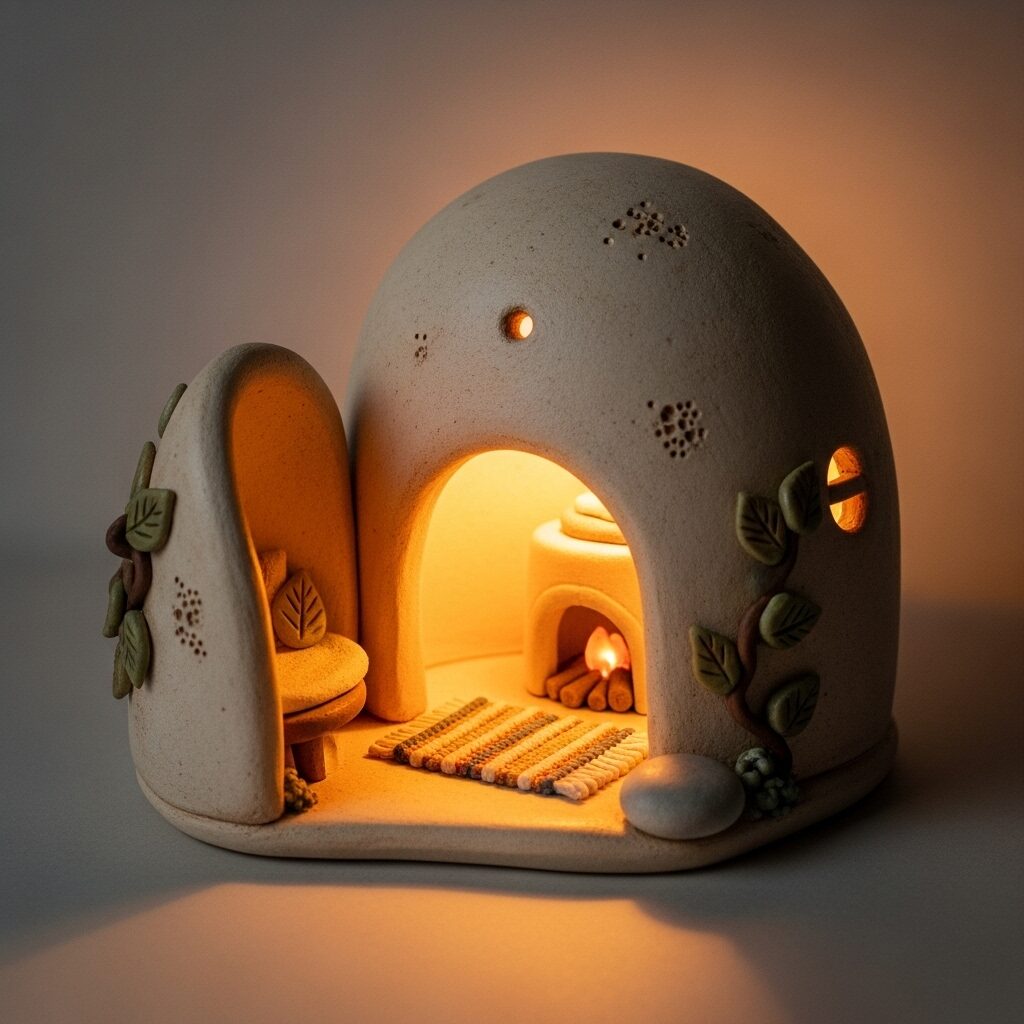
The concept of a “safe space” sculpture taps into our deep human need for security and sanctuary. This therapeutic technique involves using clay or other materials to build a small, tangible representation of a place – real or imagined – where you feel completely safe, calm, and protected.
Building Your Safe Space
Your safe space sculpture might represent:
- A childhood bedroom where you felt secure
- A peaceful natural setting like a forest clearing or beach
- An imaginary sanctuary designed specifically for comfort
- A cozy reading nook or favorite chair
- A protective shelter or cocoon-like structure
The key is to include sensory details that evoke feelings of safety: smooth surfaces for comfort, walls for protection, open spaces for freedom, or textured elements that feel good to touch. Some people add small objects or symbols that represent important people, pets, or meaningful experiences.
The Narrative Art of Collage and Mixed Media
While clay work offers the grounding benefits of three-dimensional creation, collage and mixed media provide complementary therapeutic benefits through narrative exploration and symbolic representation. These techniques work particularly well in combination with sculpting practices, offering multiple pathways for emotional expression and processing.
Why Collage Complements Clay Work
Collage feels less intimidating than drawing or painting because it works with pre-existing images, words, and textures rather than requiring creation from a blank slate. This accessibility makes it an excellent companion to clay work, allowing for the exploration of complex personal narratives, memories, and emotions through the symbolic act of selecting, arranging, and combining different elements.
The evolution of art movements shows us that mixed media approaches have consistently provided artists with powerful tools for expressing complex ideas and emotions.
Essential Emotion Collage Techniques
Creating an emotion collage offers an intuitive way to explore and express current feelings without the pressure of artistic skill. This technique involves gathering materials that resonate with your emotional state and arranging them in a way that feels authentic to your experience.
The Process
- Gather materials: Magazines, newspapers, fabric scraps, natural materials, colored paper
- Enter an intuitive state: Don’t overthink your choices
- Select resonant elements: Cut out images, colors, words, or textures that speak to your current emotion
- Arrange without judgment: Let your intuition guide the placement
- Reflect on the result: Often, surprising insights emerge from the final composition
This process helps bypass the analytical mind and allows unconscious material to surface, often revealing aspects of emotions that weren’t immediately apparent.
Vision Boards: Sculpting Your Future
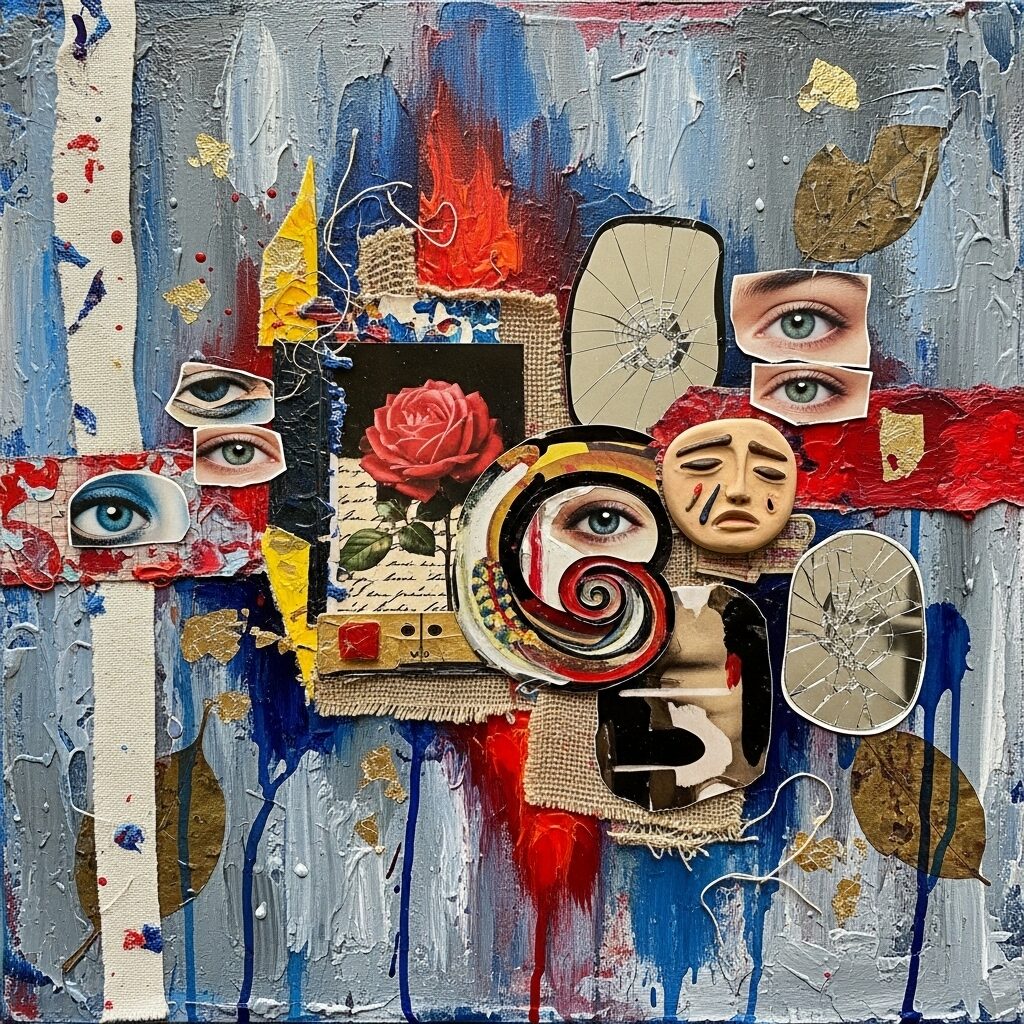
A more goal-oriented form of collage, vision boards help clarify aspirations and desired feelings while maintaining positive focus and motivation. When combined with clay work, vision boards become even more powerful – you might sculpt three-dimensional elements to add to your board or create small clay objects that represent your goals.
Creating Effective Vision Boards
Successful vision boards include:
- Specific visual representations of desired outcomes
- Emotional states you want to cultivate
- Words and phrases that inspire and motivate
- Colors and textures that feel aligned with your goals
- Personal symbols that hold meaning for you
Research from Dominican University found that people who write down their goals are 42% more likely to achieve them, and visual representation appears to enhance this effect even further.
Inside vs. Outside Self-Representation
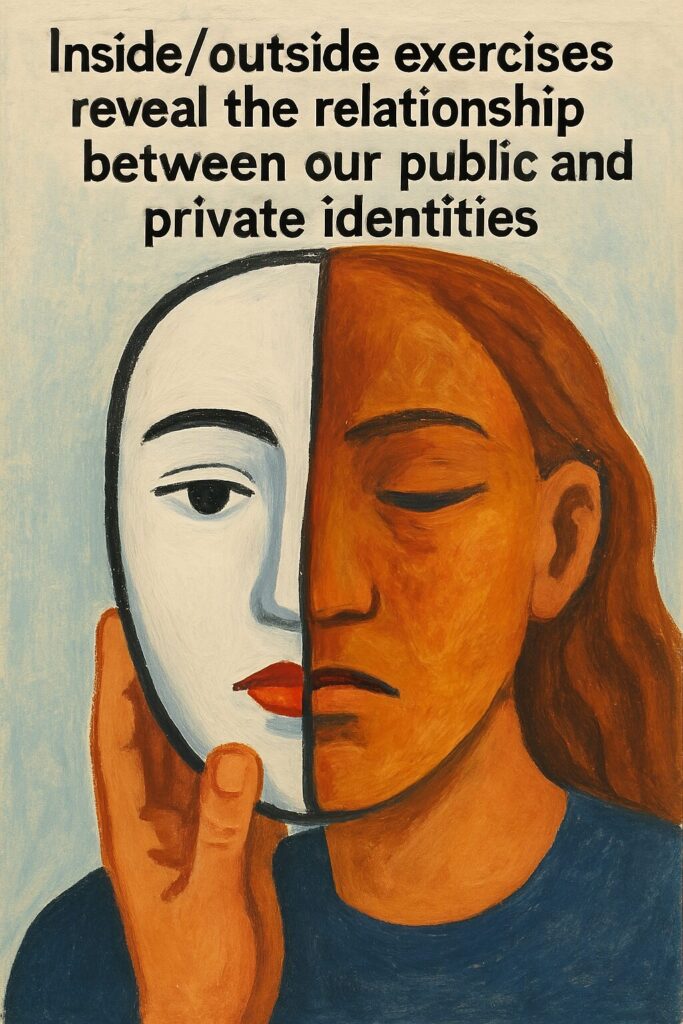
This powerful mixed-media exercise explores the relationship between our public and private selves using templates like masks, boxes, or divided silhouettes. One side represents the self presented to the outer world, while the other expresses private thoughts, feelings, and struggles.
Materials and Process
- Template options: Paper masks, shoebox, human silhouette outline
- Exterior decoration: Images, colors, and words representing your public persona
- Interior decoration: Elements representing your private inner world
- Reflection questions: What differences do you notice? What does this reveal about authenticity?
This exercise often reveals the energy it takes to maintain certain public facades and can guide conversations about authentic self-expression and emotional honesty.
Combining Techniques for Maximum Benefit
The most effective therapeutic art practice combines multiple modalities. You might start with mindful clay work to center yourself, then create an emotion sculpture to process current feelings, and finish with a collage that explores the narrative context of those emotions.
Weekly Practice Structure
Monday: Mindful kneading (10 minutes) Wednesday: Emotion sculpting (20-30 minutes)
Friday: Mixed media exploration (30-45 minutes) Sunday: Reflection and documentation in an art journal
This combination ensures you’re engaging both the grounding, present-moment benefits of clay work and the narrative, symbolic benefits of mixed media.
Scientific Research Supporting Tactile Arts Therapy
Multiple studies have documented the mental health benefits of hands-on creative practices:
- A 2016 study in PLOS ONE found that 45 minutes of art-making significantly reduced stress hormones
- Research from Drexel University showed that art-making activates the brain’s reward pathways
- The Journal of Applied Arts & Health published findings that clay work specifically reduces symptoms of anxiety and depression
The American Psychological Association now recognizes art therapy as an evidence-based treatment for various mental health conditions.
Getting Started: Practical Tips for Beginners
Essential Supplies
| Clay Work | Mixed Media | Both |
|---|---|---|
| Air-dry clay | Magazines | Scissors |
| Modeling tools | Glue sticks | Work surface |
| Water container | Colored paper | Storage containers |
| Damp cloth | Fabric scraps | Good lighting |
Setting Up Your Space
Create a dedicated area where you can work without interruption. This doesn’t need to be large – even a small table or desk corner works. The key is consistency and accessibility. Cover your work surface with newspaper or plastic, and keep supplies organized in bins or baskets.
Starting Your Practice
Begin with just 10-15 minutes of mindful clay work. There’s no need to create anything specific – focus on the sensory experience and present-moment awareness. As you become more comfortable, gradually add other techniques and extend your practice time.
Working with Professional Support
While self-directed art therapy can be incredibly beneficial, working with a trained art therapist provides additional support and insight. Art therapists are trained to help you explore the meanings and messages in your creations while maintaining appropriate therapeutic boundaries.
To find a qualified art therapist, visit the Art Therapy Credentials Board website, which maintains a directory of credentialed professionals.
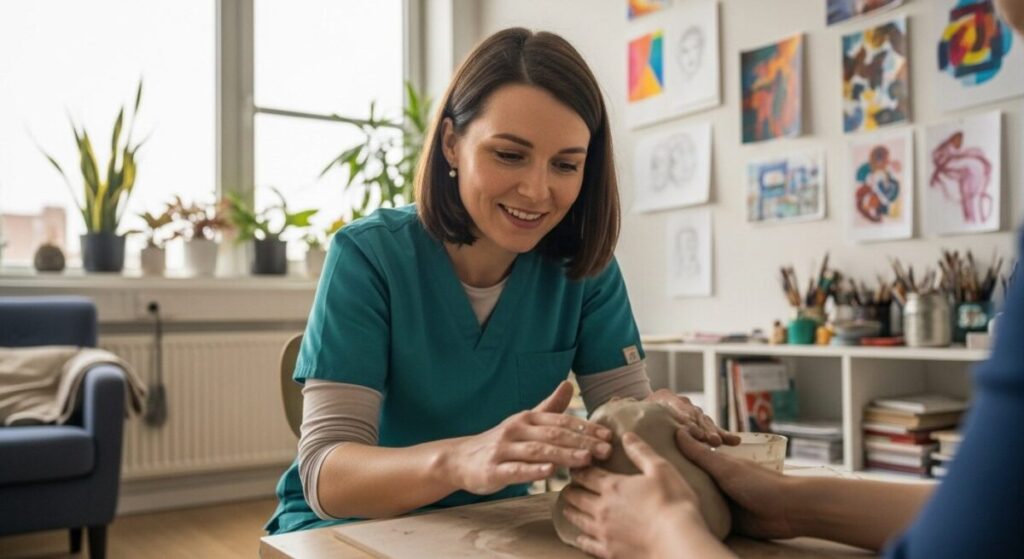
The grounding nature of tactile arts, particularly sculpting and clay work, offers a unique pathway to emotional wellness and stress relief. Through simple techniques like mindful kneading, emotion sculpting, and safe space creation, combined with the narrative possibilities of collage and mixed media, you can develop a powerful toolkit for managing anxiety, processing emotions, and cultivating present-moment awareness. Whether practiced independently or with professional guidance, these art therapy activities for stress relief provide accessible, effective methods for supporting mental health through creative expression.
Frequently Asked Questions
What type of clay is best for therapeutic work? Air-dry clay is ideal for beginners as it requires no firing and is easy to work with. Polymer clay and traditional pottery clay are also excellent options depending on your preferences and access to tools.
How long should I spend on clay therapy exercises? Start with 10-15 minutes of mindful clay work and gradually increase as you feel comfortable. Even short sessions can provide significant benefits.
Can I practice art therapy without professional training? While self-directed art-making is beneficial, working with a qualified art therapist provides additional support and deeper insight into your creative process.
What if I don’t consider myself artistic? Therapeutic art focuses on process, not product. No artistic skill is required – the healing comes from the act of creating, not the final result.
Is clay work suitable for children? Yes, clay work is excellent for children and can help them process emotions and develop fine motor skills. Always supervise young children with art materials.
Additional Resources
- American Art Therapy Association – Professional organization with resources and therapist directory
- Art Therapy Credentials Board – Find credentialed art therapists in your area
- National Center for Complementary and Integrative Health – Research on complementary health approaches including art therapy
- Psychology Today Art Therapy Section – Find local art therapists and learn about the field
- The British Association of Art Therapists – UK-based resources and professional information
Citations
- Malchiodi, C. A. (2019). Trauma and Expressive Arts Therapy: Brain, Body, and Imagination in the Healing Process. Guilford Press.
- Kaimal, G., et al. (2016). Reduction of cortisol levels and participants’ responses following art making. PLOS ONE, 11(2), e0166628.
- American Psychological Association. (2020). Art therapy for anxiety and depression. APA Practice Guidelines.
- Stuckey, H. L., & Nobel, J. (2010). The connection between art, healing, and public health. American Journal of Public Health, 100(2), 254-263.

